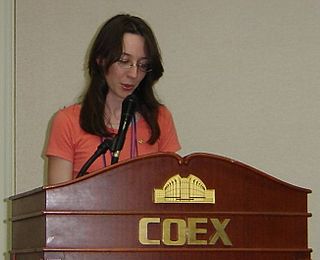
In mass communication, digital media is any communication media that operates in conjunction with various encoded machine-readable data formats. Digital content can be created, viewed, distributed, modified, listened to, and preserved on a digital electronic device, including digital data storage media and digital broadcasting. Digital is defined as any data represented by a series of digits, and media refers to methods of broadcasting or communicating this information. Together, digital media refers to mediums of digitized information broadcast through a screen and/or a speaker. This also includes text, audio, video, and graphics that are transmitted over the internet for viewing or listening to on the internet.
Technological convergence is the tendency for technologies that were originally unrelated to become more closely integrated and even unified as they develop and advance. For example, watches, telephones, television, computers, and social media platforms began as separate and mostly unrelated technologies, but have converged in many ways into an interrelated telecommunication, media, and technology industry.
Alternative media are media sources that differ from established or dominant types of media in terms of their content, production, or distribution. Sometimes the term independent media is used as a synonym, indicating independence from large media corporations, but generally independent media is used to describe a different meaning around freedom of the press and independence from government control. Alternative media does not refer to a specific format and may be inclusive of print, audio, film/video, online/digital and street art, among others. Some examples include the counter-culture zines of the 1960s, ethnic and indigenous media such as the First People's television network in Canada, and more recently online open publishing journalism sites such as Indymedia.
Media democracy is a democratic approach to media studies that advocates for the reform of mass media to strengthen public service broadcasting and develop participation in alternative media and citizen journalism in order to create a mass media system that informs and empowers all members of society and enhances democratic values.

Henry Guy Jenkins III is an American media scholar and Provost Professor of Communication, Journalism, and Cinematic Arts, a joint professorship at the University of Southern California (USC) Annenberg School for Communication and Journalism and the USC School of Cinematic Arts. He also has a joint faculty appointment with the USC Rossier School of Education. Previously, Jenkins was the Peter de Florez Professor of Humanities as well as co-founder and co-director of the Comparative Media Studies program at the Massachusetts Institute of Technology (MIT). He has also served on the technical advisory board at ZeniMax Media, parent company of video game publisher Bethesda Softworks. In 2013, he was appointed to the board that selects the prestigious Peabody Award winners.

Citizen media is content produced by private citizens who are not professional journalists. Citizen journalism, participatory media and democratic media are related principles.

Digital rhetoric is communication that exists in the digital sphere. It can be expressed in many different forms, including text, images, videos, and software. Due to the increasingly mediated nature of contemporary society, distinctions between digital and non-digital environments are less clear. This has expanded the scope of digital rhetoric to account for the increased fluidity with which humans interact with technology.

Social media are interactive technologies that facilitate the creation, sharing and aggregation of content amongst virtual communities and networks. Common features include:
Participatory media is communication media where the audience can play an active role in the process of collecting, reporting, analyzing and disseminating content. Citizen / participatory journalism, citizen media, empowerment journalism and democratic media are related principles.
A social news website is a website that features user-posted stories. Such stories are ranked based on popularity, as voted on by other users of the site or by website administrators. Users typically comment online on the news posts and these comments may also be ranked in popularity. Since their emergence with the birth of Web 2.0, social news sites have been used to link many types of information, including news, humor, support, and discussion. All such websites allow the users to submit content and each site differs in how the content is moderated. On the Slashdot and Fark websites, administrators decide which articles are selected for the front page. On Reddit and Digg, the articles that get the most votes from the community of users will make it to the front page. Many social news websites also feature an online comment system, where users discuss the issues raised in an article. Some of these sites have also applied their voting system to the comments, so that the most popular comments are displayed first. Some social news websites also have a social networking service, in that users can set up a user profile and follow other users' online activity on the website.
Participatory culture, an opposing concept to consumer culture, is a culture in which private individuals do not act as consumers only, but also as contributors or producers (prosumers). The term is most often applied to the production or creation of some type of published media.

Produsage is a portmanteau of the words production and usage, coined by German-Australian media scholar Axel Bruns and popularized in his book Blogs, Wikipedia, Second Life and Beyond: From Production to Produsage. Produsage is the type of user-led content creation that takes place in a variety of online environments, open source software, and the blogosphere. The concept blurs the boundaries between passive consumption and active production. The distinction between producers and consumers or users of content has faded, as users play the role of producers whether they are aware of this role or not. The hybrid term produser refers to an individual who is engaged in the activity of produsage. This concept is similar and related to commons-based peer production, a term coined by Yochai Benkler.

Mirko Tobias Schäfer is a media scholar at Utrecht University. He is an Associate Professor for AI, Data & Society at the Department for Information & Computing Sciences and Sciences Lead of the Data School.
Viral phenomena or viral sensations are objects or patterns that are able to replicate themselves or convert other objects into copies of themselves when these objects are exposed to them. Analogous to the way in which viruses propagate, the term viral pertains to a video, image, or written content spreading to numerous online users within a short time period. This concept has become a common way to describe how thoughts, information, and trends move into and through a human population.
Digital labor or digital labour represents an emergent form of labor characterized by the production of value through interaction with information and communication technologies such as digital platforms or artificial intelligence. Examples of digital labor include on-demand platforms, micro-working, and user-generated data for digital platforms such as social media. Digital labor describes work that encompasses a variety of online tasks. If a country has the structure to maintain a digital economy, digital labor can generate income for individuals without the limitations of physical barriers.
Connectivity refers broadly to social connections forged through mediated communications systems. That is, "since the arrival of the World Wide Web and the spread of mobile communications, mediated connectivity has been quietly normalized as central to a consolidating 'global imaginary'". One aspect of this is the ability of the social media to accumulate economic capital from the users' connections and activities on social media platforms by using certain mechanisms in their architecture. According to several scholars "it is a key element of social media logic, having a material and metaphorical importance in social media culture". This concept originates from the technological term of "connectivity" but its application to the media field has acquired additional social and cultural implications. The increasing role of social media in everyday life serves as the basis of such connectivity in the 21st century. It shows the interrelations between the users activities on social media and at the same time the empowerment of the social media platforms with the data that was produced by the users and given to those services for granted.
The history of humor on the Internet begins together with the Internet itself. Initially, the internet and its precursors, LANs and WANs, were used merely as another medium to disseminate jokes and other kinds of humor, in addition to the traditional ones. In lockstep with the progress of electronic communication technologies, jokers took advantage of the ARPANET, e-mail, Usenet newsgroups, bulletin board systems, etc., and finally the Whole World Wide Web. Gradually, new forms of humor evolved, based on the new possibilities delivered by electronic means of communication. Popular forms of internet humour are found in the form of 'internet memes', GIFs, and short form videos. Reaction videos, where amusement is expressed through a person's response to something, are another prevalent form of humor unique to the internet.
Participatory surveillance is community-based monitoring of other individuals. This term can be applied to both digital media studies and ecological field studies. In the realm of media studies, it refers to how users surveil each other using the internet. Either through the use of social media, search engines, and other web-based methods of tracking, an individual has the power to find information both freely or non freely given about the individual being searched. Issues of privacy emerge within this sphere of participatory surveillance, predominantly focused on how much information is available on the web that an individual does not consent to. More so, disease outbreak researchers can study social-media based patterns to decrease the time it takes to detect an outbreak, an emerging field of study called infodemiology. Within the realm of ecological fieldwork, participatory surveillance is used as an overarching term for the method in which indigenous and rural communities are used to gain greater accessibility to causes of disease outbreak. By using these communities, disease outbreak can be spotted earlier than through traditional means or healthcare institutions.
Convergence culture is a theory which recognizes changing relationships and experiences with new media. Henry Jenkins is accepted by media academics to be the father of the term with his book Convergence Culture: Where Old and New Media Collide. It explores the flow of content distributed across various intersections of media, industries and audiences, presenting a back and forth power struggle over the distribution and control of content.
Fan studies is an academic discipline that analyses fans, fandoms, fan cultures and fan activities, including fanworks. It is an interdisciplinary field located at the intersection of the humanities and social sciences, which emerged in the early 1990s as a separate discipline, and draws particularly on audience studies and cultural studies.